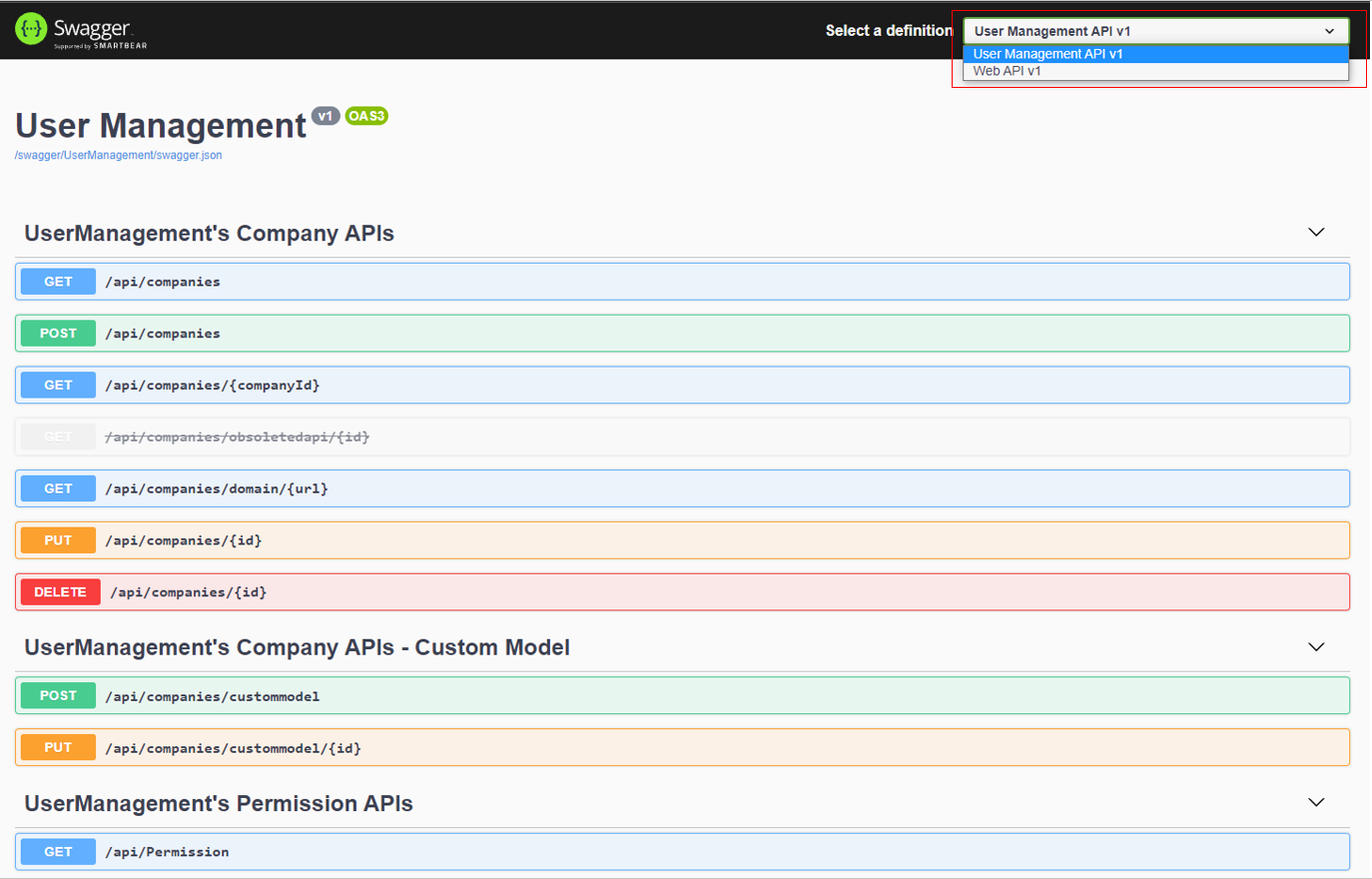User Management and Authorization
DNVGL.Authorization.UserManagement.ApiControllers provides restAPIs to manage user, role and company. It also provides mechanisms to authorize API endpoints. Go through Overview to understand the logic behind the package. Check out Demo Projects.
Prerequisites
PM> Install-Package DNVGL.Authorization.UserManagement.ApiControllers
PM> Install-Package DNVGL.Authorization.UserManagement.EFCore
Basic Usage
This simple example will show you the minimum steps to setup user management and authorization in a ASP.NET Core project. The example uses SQL Server as database and Veracity authentication (Azure AD B2C).
1. register user management module in ASP.NET core project.
PM> Install-Package Microsoft.EntityFrameworkCore.SqlServer
public class Startup
{
//...
public void ConfigureServices(IServiceCollection services)
{
//...
services.AddUserManagement().UseEFCore(new EFCoreOptions
{
DbContextOptionsBuilder = options => options.UseSqlServer(@"Data Source=.\SQLEXPRESS;Initial Catalog=UserManagement;Trusted_Connection=Yes;")
});
//...
}
public void Configure(IApplicationBuilder app, IWebHostEnvironment env)
{
//...
//Put UseRouting or MapControllers before UseAuthentication and UseAuthorization
//app.MapControllers();
app.UseRouting();
app.UseAuthentication().UseAuthorization();
//...
//...
//The following code is required if app.UseRouting() is used instead of app.MapControllers();
app.UseEndpoints(endpoints =>
{
//...
endpoints.MapDefaultControllerRoute();
});
//...
}
}
2. Create tables in database
Find and execute NewTableScript.sql which is located at the content directory once you imported the package in your project.
3. Create a super admin in Table - Users.
The following is sample. | Id | Email | FirstName | LastName | VeracityId | SuperAdmin | Active | Deleted | |--|--|--|--|--|--|--|--| | 1 | email | first name | last name | veracity id | 1 | 1 | 0
4. Generate Swagger api documentation (Optional)
NOTE: This step is optional. You can generate API docs in your own way. The following code has dependency on Nuget package -
Swashbuckle.AspNetCore. Additionaly, you will get more explanation if you setapidocs/DNVGL.Authorization.UserManagement.ApiControllers.xml's Copy to Output Directory as Copy Always.
public class Startup
{
//...
public void ConfigureServices(IServiceCollection services)
{
//...
services.AddControllers();
services.AddSwaggerGen(c =>
{
// swagger documentaion group for User Management.
c.SwaggerDoc("UserManagement", new OpenApiInfo
{
Title = "User Management",
Version = "v1"
});
// swagger documentaion group for your system.
c.SwaggerDoc("WebAPI", new OpenApiInfo
{
Title = "Web API",
Version = "v1"
});
c.TagActionsBy(api =>
{
if (api.GroupName != null)
{
return new[] { api.GroupName };
}
var controllerActionDescriptor = api.ActionDescriptor as ControllerActionDescriptor;
if (controllerActionDescriptor != null)
{
return new[] { controllerActionDescriptor.ControllerName };
}
throw new InvalidOperationException("Unable to determine tag for endpoint.");
});
c.DocInclusionPredicate((name, api) =>
{
if (name == "UserManagement")
return api.GroupName != null && api.GroupName.StartsWith("UserManagement");
else
return api.GroupName == null;
});
var xmlFile = $"DNVGL.Authorization.UserManagement.ApiControllers.xml";
var xmlPath = Path.Combine(AppContext.BaseDirectory, xmlFile);
if (File.Exists(xmlPath))
c.IncludeXmlComments(xmlPath);
});
//...
}
//...
public void Configure(IApplicationBuilder app, IWebHostEnvironment env)
{
//...
app.UseSwagger();
app.UseSwaggerUI(c =>
{
c.SwaggerEndpoint("/swagger/UserManagement/swagger.json", "User Management API v1");
c.SwaggerEndpoint("/swagger/WebAPI/swagger.json", "Web API v1");
});
//...
}
}
5. Explore user management APIs
Build and Run your project.
Open swagger in Browser

6. Define permissions
Define permissions by implementing interface - IPermissionMatrix. The following code defined two permissions.
public class PermissionBook : IPermissionMatrix
{
public enum WeatherPermission
{
//...
[PermissionValue(id: "8", key: "ReadWeather", name: "Read Weather", group: "Weather", description: "ReadWeather")]
ReadWeather,
[PermissionValue(id: "8", key: "WriteWeather", name: "Write Weather", group: "Weather", description: "WriteWeather")]
WriteWeather,
//... other permissions
}
}
7. Authorize API with permissions
Decorates API actions with permission.
[HttpGet]
[PermissionAuthorize(WeatherPermission.ReadWeather)]
public IEnumerable<WeatherForecast> Get()
{
//... api logic
}
Recommended content
Something you need to know before using the package to handle user management and authorization.
Integration with ASP.NET Core's Role-based authorization ✓
Integrate user management module with Role-based authorization in ASP.NET Core. In this way, you are allowed to authorize API with asp.net core's
[Authorize(Roles = "****")].
Guidance for different databases
Use Azure CosmosDB as database
User other databases.
The package can use all database engines supported by EF Core 5.0+. Here is a list - EF Core 5.0 Database providers
Guidance for configuration
Guidance for customization
Extend Data model - Company, Role, User
Replace EF Core with your own data access
Guidance for access control ✓
Resource access control guide you to control access on resource of company.